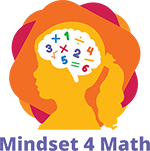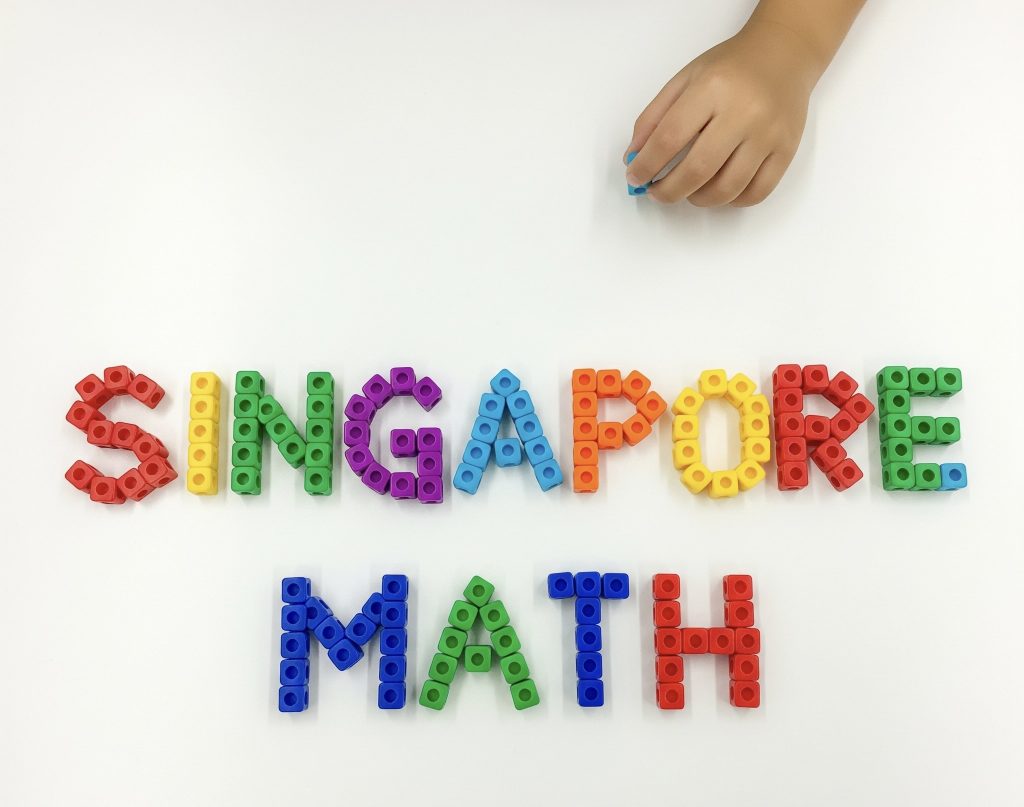In recent years, Singapore Math has gained worldwide popularity, transforming how children approach and learn math. But what makes this method so effective? How can you support your child’s learning journey at home?
With years of experience teaching math, leading intervention classes, and training educators and parents, I’ve seen firsthand how Singapore Math helps primary and middle school students grasp concepts deeply and solve problems confidently. In this guide, we’ll explore what Singapore Math is, why it works, and how it can benefit your child.
What is Singapore Math?
Singapore Math is an innovative approach to teaching math, developed by Singapore’s Ministry of Education. It’s based on research, pedagogy, and learning theories and has earned global recognition for producing strong, confident math learners.
Key Features of Singapore Math
✔ Concrete-Pictorial-Abstract (CPA) Approach
This three-step learning process is at the core of Singapore Math:
- Concrete: Students start with hands-on learning using physical objects.
- Pictorial: They move on to visual representations, like bar models and diagrams.
- Abstract: Finally, they work with symbols and equations.
Watch this video to learn more about how the CPA approach works.
✔ Why Before How
Singapore Math emphasizes understanding concepts before applying procedures. Students learn why a math strategy works before learning how to use it.
✔ Focus on Problem Solving
Problem-solving is at the heart of the Singapore Math curriculum. It trains students to think critically and solve both routine and non-routine problems.
Learn more about routine and non-routine problems in this video.
✔ Develops Visualization
Visualization helps students “see” math in their minds. Bar models, a signature tool in Singapore Math, help students break down word problems by drawing and labeling rectangles to represent known and unknown quantities.
Watch this video to see how the bar model method can help children solve complex problems.
✔ Mastery-based learning
Singapore Math prioritizes depth over speed. Students focus on fewer topics but explore them in greater detail to achieve mastery before moving on.
✔ Spiral Curriculum
Rather than covering a topic once and moving on, Singapore Math revisits concepts over time at more advanced levels. This helps reinforce understanding, fill gaps, and build long-term mastery.
The picture below shows an example of how a topic is revisited in Singapore Math:
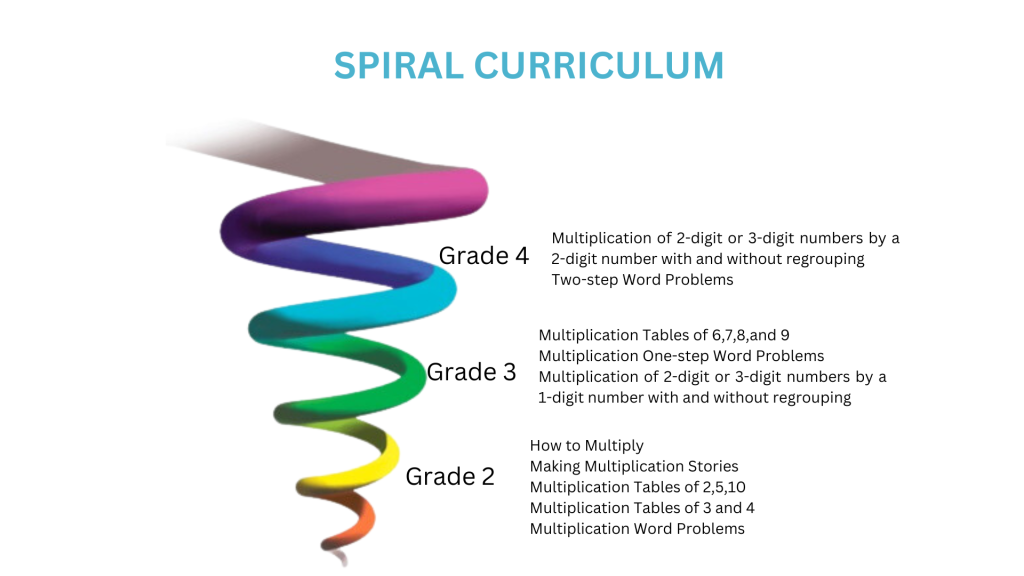
✔ Mental Math
Students develop mental math skills by learning efficient strategies and building a strong number sense. Instead of memorizing tricks, they understand why each strategy works.
Here is an example of a mental math strategy used in Singapore Math.
Why is Singapore Math effective?
Singapore Math has become a global success because it has been proven to enhance students’ mathematical understanding and problem-solving abilities.
Here are some reasons why Singapore Math works:
- Focus on Concept Mastery: Singapore Math prioritizes understanding concepts rather than simply teaching to the test.
- Research-Based Curriculum: The curriculum is grounded in educational research and learning theories.
- Multiple Problem-Solving Strategies: Students are encouraged to explore different ways to solve a problem, which builds critical thinking and confidence.
- Effective Mental Math: Students develop mental math skills by learning the reasoning behind strategies, not just memorizing tricks.
- Varied Practice: Teachers provide varied exercises so students can apply their knowledge in new situations.
- Regular Curriculum Updates: Singapore’s curriculum is continually revised to keep students prepared for future challenges.
- Teacher Training: Educators receive extensive training to effectively teach Singapore Math.
Pros and Cons of Singapore Math
Are you thinking of teaching Singapore Math to your child? Here are the advantages and potential challenges to consider:
Pros of Using Singapore Math
Strong Conceptual Understanding: Singapore Math focuses on really understanding math concepts instead of just memorizing formulas. Students learn to think critically and truly understand math concepts.
Emphasis on Problem-Solving: Teachers focus on helping students solve problems using multiple strategies.
Clear and Engaging Materials or Resources: The textbooks and workbooks are user-friendly, with clear visuals and easy-to-read content.
Proven Results: Singapore students consistently rank high in international math assessments.
Cons of Using Singapore Math
Challenging for Some Students: Students used to memorization-based math may find the problem-solving focus initially difficult.
Requires Teacher Training: Educators need proper training to effectively use the concrete-pictorial-abstract (CPA) approach and teach the bar model method.
Requires Parent Training: Parents may have difficulty teaching their children Singapore Math at home since they were taught Math the traditional way. Thus, it is helpful for parents to attend parent orientation or seminars on Singapore Math.
Adjustment Period: Students transitioning from traditional math programs may need time and practice to adapt to the Singapore Math approach. However, with practice and support, they usually develop stronger math skills in the long run.
Singapore Math in the Philippines
Because of its proven effectiveness, many schools worldwide have adopted the Singapore Math curriculum, including several in the Philippines. Some Philippine schools using Singapore Math to enhance students’ critical thinking and problem-solving skills include:
- Ateneo de Manila
- Xavier School
- Immaculate Conception Academy
- Reedley International School
- MGC New Life Christian Academy
- Keys School Manila
- Meridian International Learning Experience
- The Raya School
How is Singapore Math different?
Parents and educators often compare Singapore Math to other popular math programs like Traditional Math, Kumon, and Saxon Math. While each has its strengths, Singapore Math stands out for its emphasis on deep conceptual understanding, problem-solving, and a visual, step-by-step learning process. Let’s explore how it differs from these methods.
Singapore Math vs. Traditional Math
Singapore Math shifts the focus from memorization to understanding. Traditional Math often emphasizes formulas and rote learning, while Singapore Math introduces concepts using hands-on materials (like counters), visual models (like bar diagrams), and abstract numbers. This Concrete-Pictorial-Abstract (CPA) approach makes math easier to grasp and helps kids retain what they learn.
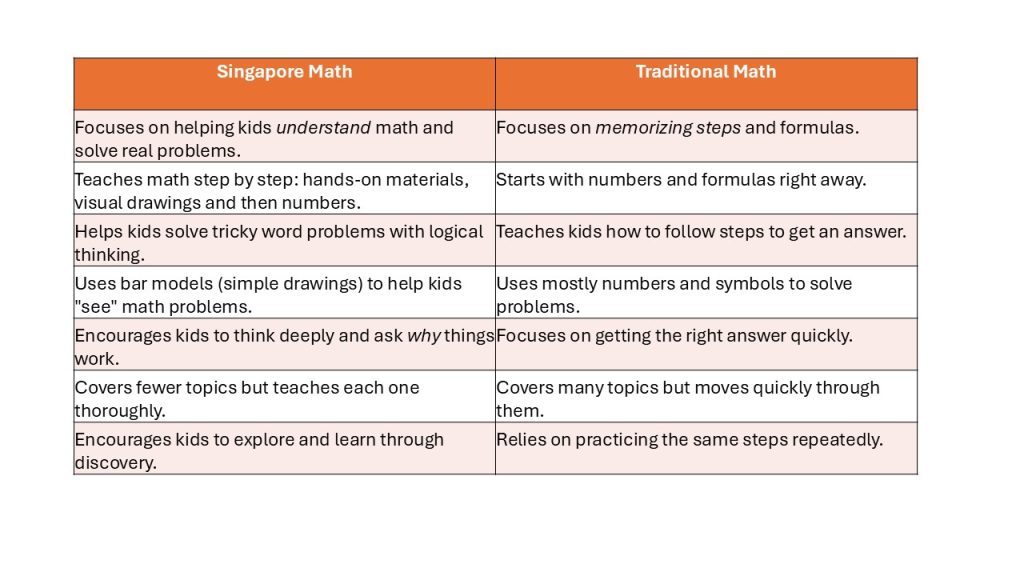
Singapore Math vs. Kumon
Unlike Kumon, which emphasizes repetition and daily drills to build fluency, Singapore Math prioritizes conceptual understanding and problem-solving. Both approaches are effective in different ways, but Singapore Math helps kids develop a flexible, creative mindset by encouraging them to think critically about how and why math strategies work.
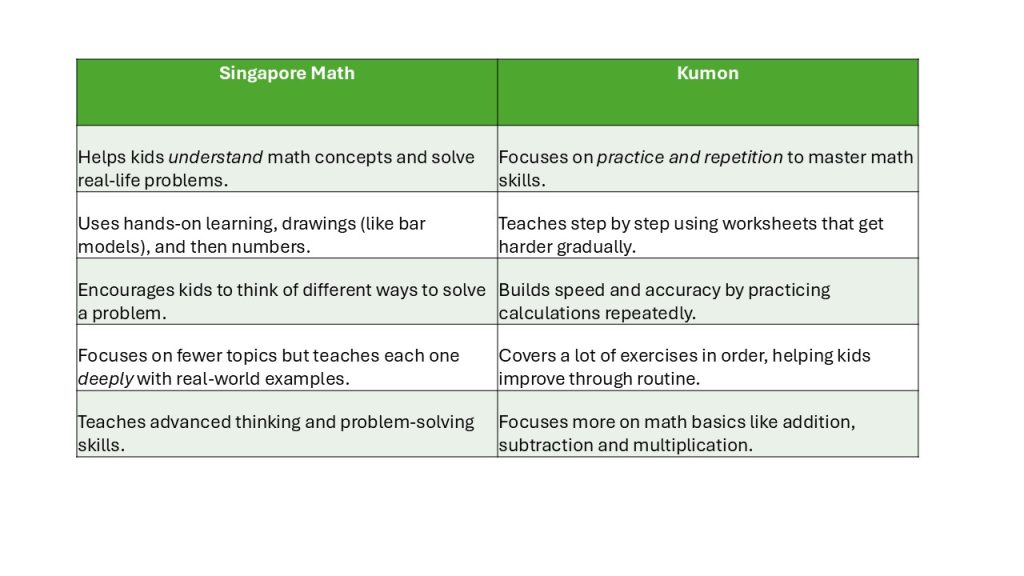
Singapore Math vs. Saxon Math
Saxon Math focuses on incremental learning and frequent review, breaking lessons into smaller, manageable chunks. Singapore Math, by contrast, emphasizes mastery—students dive deep into one concept before moving on to the next. This helps build a strong foundation and reduces the need for constant review.
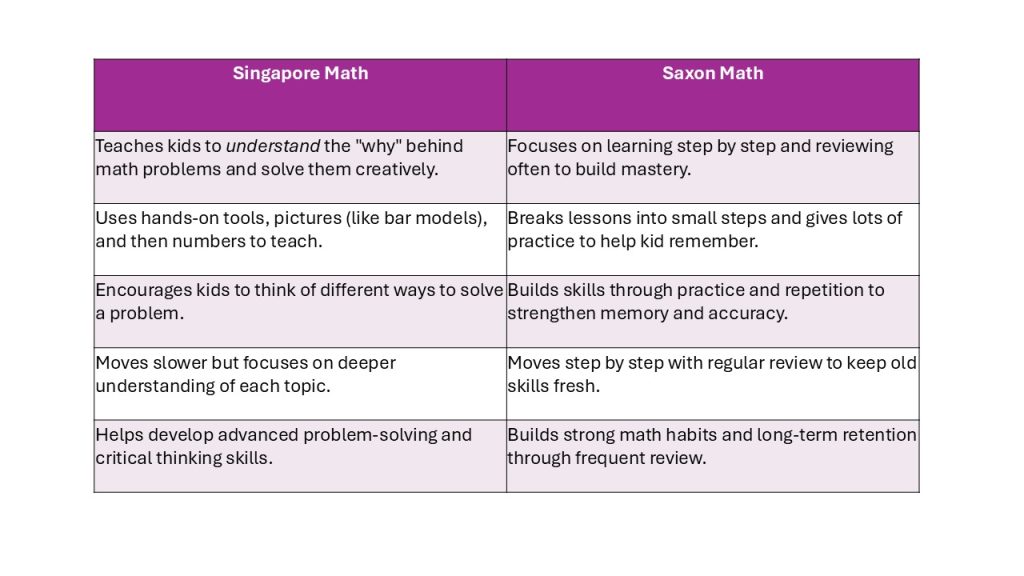
Common Misconceptions About Singapore Math
Although Singapore Math has a proven track record of success, some parents and educators hesitate to adopt it due to misconceptions. Let’s debunk some of these myths:
Myth #1: Singapore Math is only for advanced students.
Fact: Singapore Math is designed for all learners, regardless of their math ability. The CPA approach (Concrete-Pictorial-Abstract) helps struggling students understand complex concepts by breaking them down into manageable steps.
Myth #2: It is just another curriculum or textbook series.
Fact: Singapore Math is more than a curriculum—it’s a teaching method. Schools that adopt Singapore Math often transform how they teach, focusing on building a deep conceptual understanding, not just switching to new books.
Myth #3: Singapore Math is difficult and too advanced for young learners.
Fact: While Singapore Math introduces some concepts earlier than traditional programs, it follows a logical progression that builds on prior knowledge. The CPA approach makes even advanced topics easier to understand.
Myth #4: It doesn’t emphasize memorization, so kids won’t master basic math facts.
Fact: Singapore Math helps kids master math facts through understanding, not just drills. By using strategies like number bonds (breaking numbers apart) and pattern recognition, children build both fluency and number sense.
Myth #5: It eliminates traditional algorithms and formulas.
Fact: Singapore Math teaches traditional algorithms only after students understand the underlying concepts. For example, instead of immediately teaching the long division algorithm, students first learn how division works through visual models and number sense strategies (like breaking apart strategy). This practice ensures they truly understand the process before applying standard formulas.
How to Get Started Using Singapore Math
Are you ready to begin your child’s Singapore Math journey? Here’s how to get started:
Step 1: Assessment (Placement Tests)
The first step in transitioning to Singapore Math is to assess the child’s current math skills through placement tests. This assessment (placement test) will identify the child’s strengths and weaknesses and determine the appropriate starting point.
Mindset 4 Math offers a comprehensive assessment or placement test as part of the training package for parents. The expert-led assessment will evaluate the child’s math level, identify areas for improvement, and provide personalized recommendations for effective Singapore Math instruction.
Step 2: Attend Singapore Math Orientation for Parents
If your child’s school uses Singapore Math, check if they offer orientation sessions for parents. These sessions can help you teach math effectively at home and prevent confusion if you’re used to traditional methods.
Mindset 4 Math provides one-on-one online Singapore Math training for parents, including assessment, class demonstration, and follow-up consultations.
Step 3: Get Hands-on Materials or Math Manipulatives
Consider using math manipulatives (like counters, base-ten blocks, and fraction bars) to help your child understand math concepts. These tools make abstract ideas more concrete and boost your child’s confidence.
Watch this video to see some examples of useful Singapore Math manipulatives.
Step 4: Invest in Singapore Math Textbooks and Workbooks
Quality textbooks and workbooks guide children through the CPA method and teach essential problem-solving techniques.
The book Singapore Math: Bar Model Method (From Beginner to Advanced Level) empowers children to solve word problems using bar modeling. It includes QR codes linking to video explanations for each problem, helping kids master the technique.
FAQs: What is Singapore Math?
What is Singapore Math?
Singapore Math is a curriculum developed by Singapore’s Ministry of Education. It focuses on deep conceptual understanding, problem-solving, and visualization.
What are the benefits of Singapore Math?
Singapore Math effectively helps children grasp mathematical concepts. It also develops children’s critical thinking, creativity, problem-solving, and mental math skills—key competencies for success in today’s world.
Which schools offer Singapore Math in the Philippines?
Several schools in the Philippines, such as Ateneo de Manila, Xavier School, Immaculate Conception Academy, Reedley International School, MGC New Life Christian Academy, Keys School Manila, Meridian International Learning Experience, and The Raya School, have adopted the Singapore Math curriculum.
What age group is Singapore Math designed for?
In the Philippines, Singapore Math is typically taught from Kindergarten to Grade 6. Students who learn through this approach find it easier to tackle advanced concepts in higher grades.
How is Singapore Math different from traditional math?
In traditional math, the focus is often on memorizing formulas and procedures. Students learn to follow steps to solve problems, but they may not fully understand why those steps work. This approach can lead to a surface-level understanding, where kids know how to get the answer but struggle when faced with more complex or unfamiliar problems.
The Key Difference: Problem-Solving vs. Repetition
In many traditional math programs, repetition is the main way to learn—practice makes perfect, right? While repetition can help build fluency, it doesn’t always lead to deep understanding.
In contrast, Singapore Math focuses on problem-solving and critical thinking. Students learn why math strategies work, so they can adapt and apply their knowledge to different types of problems.
How is Singapore Math different from Kumon?
Singapore Math emphasizes conceptual understanding and problem-solving. Kumon, on the other hand, focuses on repetition and mastery through daily practice. While Singapore Math nurtures critical thinking skills, Kumon enhances math fluency and independent learning through consistent drills.
The Key Difference:
While Singapore Math nurtures critical thinking and problem-solving, Kumon strengthens math fluency and discipline through repetitive exercises.
How is Singapore Math different from Saxon Math?
Singapore Math helps children understand math deeply using a concrete-pictorial-abstract approach. In contrast, Saxon Math breaks lessons into smaller steps and frequently revisits topics to reinforce learning. While Singapore Math emphasizes mastering concepts before moving on, Saxon Math focuses on gradual skill-building through continuous practice.
The Key Difference:
Singapore Math emphasizes deep mastery, while Saxon Math builds skills gradually through continuous practice and review.
What is the bar model method?
The bar model method is a powerful problem-solving strategy used in Singapore Math. It helps students visualize math problems by drawing rectangular bars to represent numbers and their relationships.
By simplifying complex word problems with bar models, children can break down tricky math concepts like addition, subtraction, multiplication, division, and fractions.
How can I teach the bar model method to my child?
If you want to teach the bar model method at home, follow these simple steps:
- Start Small: Begin with basic word problems. Use bars to visually represent numbers and help your child understand the relationship between quantities.
- Gradually Increase Complexity: Once your child is comfortable, introduce more advanced problems, like multiplication, division, and fractions.
- Encourage Adjustments: Help your child label and adjust their bar models as they solve more challenging problems.
Want to Dive Deeper?
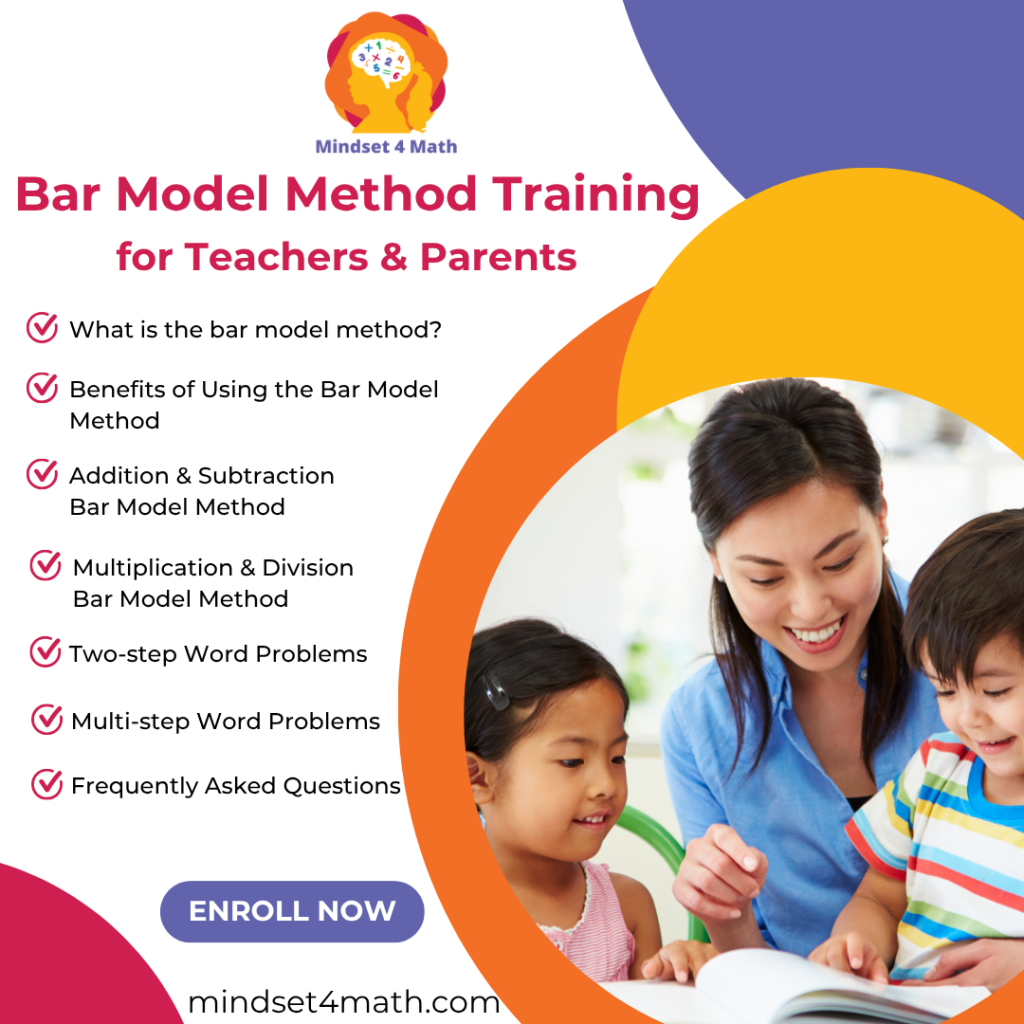
- Enroll in Mindset 4 Math’s Bar Model Method Webinar for Parents and Teachers to learn step-by-step techniques.
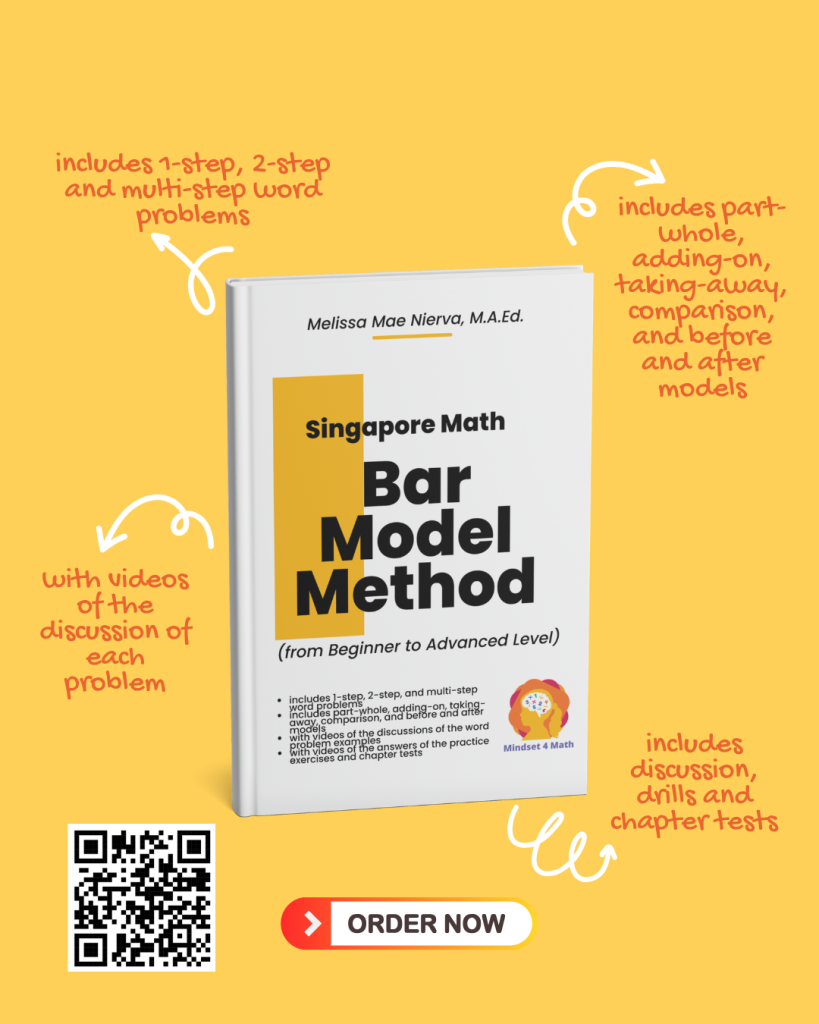
- Grab the e-book or printed copy of Singapore Math: Bar Model Method (From Beginner to Advanced Level) for hands-on practice. This book includes video explanations to help your child master the bar model method.
How can I learn more about Singapore Math?
Ready to explore Singapore Math more deeply? Here are a couple of ways to get started:
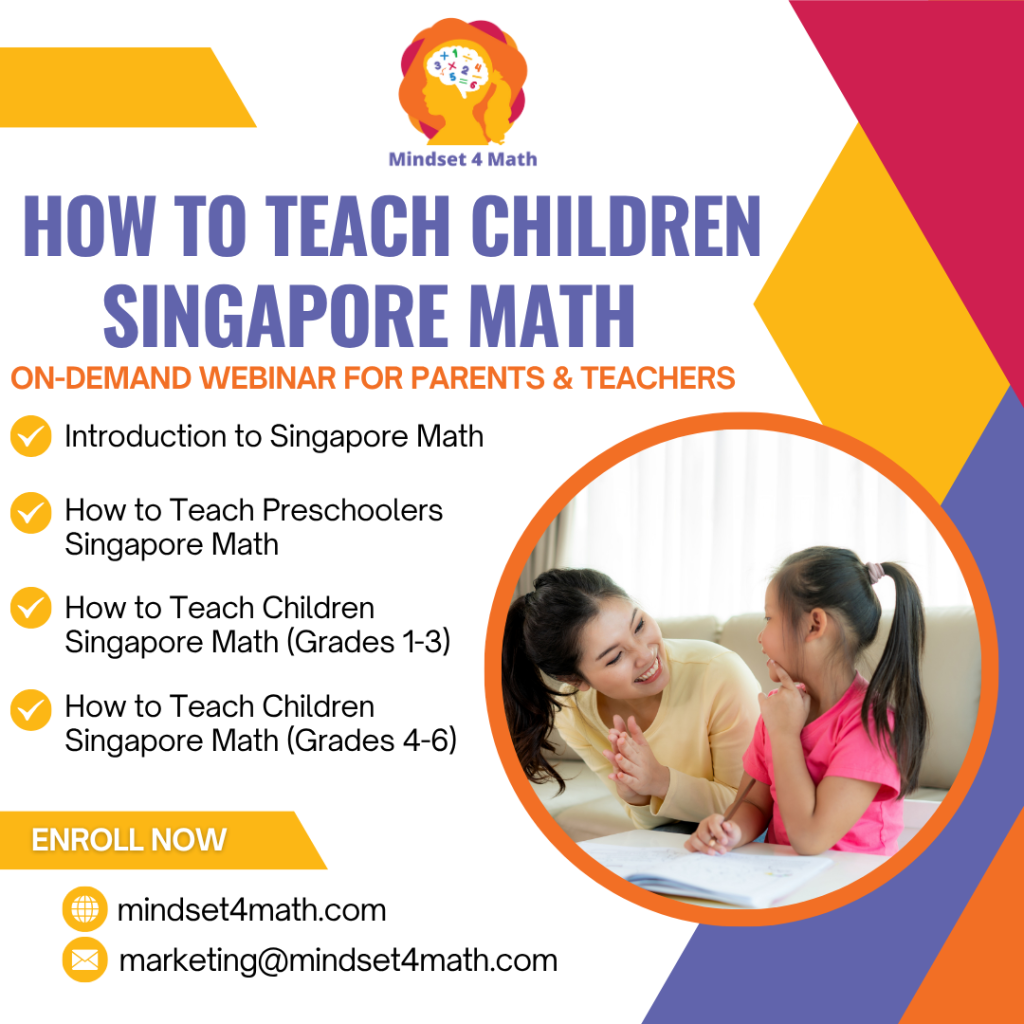
- Attend an On-Demand Webinar: Enroll in Mindset 4 Math’s How to Teach Children Singapore Math on-demand webinar for parents and teachers. This training covers how to teach Singapore Math to students in preschool, Grades 1-3, and Grades 4-6.
- Get Personalized Training: If you prefer a customized approach, register for Mindset 4 Math’s one-on-one online Singapore Math Training for parents. This tailored program will be adapted to your child’s grade level and learning needs.
Can I teach Singapore Math to a child with special needs?
Yes! One of the best things about Singapore Math is its flexibility. Because of its visual, hands-on, and step-by-step approach, it can be adapted for children with special needs.
By starting with hands-on tools and visual drawings, children can build a deeper understanding of math concepts before moving on to abstract numbers. With patience, personalized teaching, and the right support, children with special needs can develop strong math skills and confidence in problem-solving.
Final Thoughts: What is the Singapore Math curriculum?
The Singapore Math curriculum transforms how children learn and apply math in everyday situations. It challenges the idea that math is only about quick calculations and shows that math is really about thinking, analyzing, and solving problems.
As a Singapore Math consultant, trainer, and teacher, I’ve seen countless students transition from struggling learners to confident problem solvers. With proper guidance, your child can thrive in math, too.
Starting something new can feel overwhelming, but you don’t have to do it alone. Explore Singapore Math today—and watch your child’s math skills soar!
Ready to Get Started?
- Join our Bar Model Method Webinar.
- Check out the Singapore Math: Bar Model Method e-book or printed book.
- Sign up for personalized online training to support your child’s math journey.
